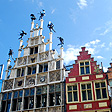FRIDAY
MARKET SQUARE - GHENT
Flemish Guilds and Jacob Van Artevelde Statue
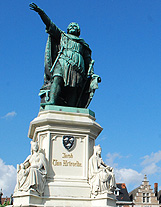 I
find myself in front of another statue in a city square wondering,
who is that mighty
figure who warrants such an honor. The Friday Market
Square (Vrijdagmarkt) of Ghent, Belgium gets its name from centuries
of town markets held there since 1199, as the historical center of
city in the middle ages. The man whose statue holds forth,
dressed with sword
at his side and badges of honor, pointing off toward an unfulfilled
destiny is not a king or prince, but a businessman, a politician, a
hero and
a kind of dictator of his day. Born to a wealthy but not noble family,
Jacob Van Artevelde became a hero in Ghent as the leader of the medieval
guilds when cloth was Flanders’ principal industry and this was
the second largest city in Europe after Paris.
I
find myself in front of another statue in a city square wondering,
who is that mighty
figure who warrants such an honor. The Friday Market
Square (Vrijdagmarkt) of Ghent, Belgium gets its name from centuries
of town markets held there since 1199, as the historical center of
city in the middle ages. The man whose statue holds forth,
dressed with sword
at his side and badges of honor, pointing off toward an unfulfilled
destiny is not a king or prince, but a businessman, a politician, a
hero and
a kind of dictator of his day. Born to a wealthy but not noble family,
Jacob Van Artevelde became a hero in Ghent as the leader of the medieval
guilds when cloth was Flanders’ principal industry and this was
the second largest city in Europe after Paris.
Jacob Van Artevelde
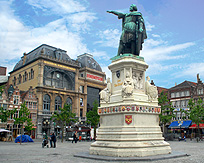 When the Burgundian Count of Flanders, Louis I, (see Gravensteen
Castle), left Flanders in the face of a rising unrest after his
switching sides
to support the French king in 1332, Van Artevelde rose to defacto
ruler of Ghent and the Flemish towns, in a period where the guilds
were the
government, the first taste in Europe of an alternative to feudal
rule. Artevelde also holds a place in history at the fulcrum
of the beginning
of the Hundred Years War. When France’s King Charles IV died without
a direct male heir, the next king, Phillip Valois, was chosen from a
cousin line as Philip VI. In France, the Salic Law dictated that the
crown could not pass through the female, but England’s King Edward
III, as Duke of Aquitaine, claimed the right to the French throne through
his mother Isabella, daughter of Philip IV, making him the closest direct
descendent. Flanders was closely allied with England through the wool
and weaving trade, Flemish weavers making cloth of English wool and selling
it back to England, and through Edward’s marriage to Philippa of
Hainaut (see Westminster Abbey).
When the Burgundian Count of Flanders, Louis I, (see Gravensteen
Castle), left Flanders in the face of a rising unrest after his
switching sides
to support the French king in 1332, Van Artevelde rose to defacto
ruler of Ghent and the Flemish towns, in a period where the guilds
were the
government, the first taste in Europe of an alternative to feudal
rule. Artevelde also holds a place in history at the fulcrum
of the beginning
of the Hundred Years War. When France’s King Charles IV died without
a direct male heir, the next king, Phillip Valois, was chosen from a
cousin line as Philip VI. In France, the Salic Law dictated that the
crown could not pass through the female, but England’s King Edward
III, as Duke of Aquitaine, claimed the right to the French throne through
his mother Isabella, daughter of Philip IV, making him the closest direct
descendent. Flanders was closely allied with England through the wool
and weaving trade, Flemish weavers making cloth of English wool and selling
it back to England, and through Edward’s marriage to Philippa of
Hainaut (see Westminster Abbey).
In a medieval political chess game, in 1337, Phillip VI confiscated
Gascony from Edward’s hold in Aquitaine. Flanders took a neutral stance
in the succession conflict as long as the weaving trade flourished, but
Edward countered with a boycott of Flemish cloth. Artevelde persuaded
the Federation of Guilds who controlled the towns of Flanders to side
with England and recognize Edward as sovereign of France and Lord of
Flanders. In the first great naval battle of English history, Edward
III’s outnumbered ships destroyed the French fleet at Sluys in
1340. English forays into France from Flanders were largely unsuccessful,
but Edward’s later landing at Normandy and the battles of Crecy
and Poitiers more decisive, though the matter wasn’t settled for
another 115 years with the marriage of Catherine Valois to Henry V.
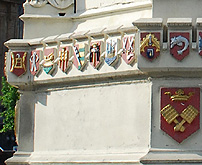 Flemish cloth trade had flourished under the influence of Jacob Van
Artevelde, but a rioting mob sealed his fate. Two factions of the
guilds, the weavers
(weave the cloth) and the fullers (flatten and beat the cloth) met
in a clash on the market square on Monday, May 4, 1345, turning the
flagstones
into a bloodbath with 1,500 killed, the day now called Evil Monday.
In a bid to seal the English alliance, Artevelde had urged the town
councils
of Flanders to accept King Edward’s 15 year old son, the Prince
of Wales, later called The Black Prince for the color of his armor at
the Battle of Crecy, as Duke of Flanders. While on a journey through
the towns promoting the alliance, the leader of the weavers, Gerard Denis,
spread rumors that Artevelde had embezzled from guild coffers. When Artevelde
returned to Ghent, he was greeted by an angry mob. He made it his house
and tried to address the crowd, but they broke in and Denis cut his rival
down with a butcher’s ax. The statue of Jacob Van Artevelde by
artist Devigne-Quyo erected in 1863 with its base surrounded by the shields
of the medieval trade guilds points in the general direction of England,
toward the source of his destiny and his downfall.
Flemish cloth trade had flourished under the influence of Jacob Van
Artevelde, but a rioting mob sealed his fate. Two factions of the
guilds, the weavers
(weave the cloth) and the fullers (flatten and beat the cloth) met
in a clash on the market square on Monday, May 4, 1345, turning the
flagstones
into a bloodbath with 1,500 killed, the day now called Evil Monday.
In a bid to seal the English alliance, Artevelde had urged the town
councils
of Flanders to accept King Edward’s 15 year old son, the Prince
of Wales, later called The Black Prince for the color of his armor at
the Battle of Crecy, as Duke of Flanders. While on a journey through
the towns promoting the alliance, the leader of the weavers, Gerard Denis,
spread rumors that Artevelde had embezzled from guild coffers. When Artevelde
returned to Ghent, he was greeted by an angry mob. He made it his house
and tried to address the crowd, but they broke in and Denis cut his rival
down with a butcher’s ax. The statue of Jacob Van Artevelde by
artist Devigne-Quyo erected in 1863 with its base surrounded by the shields
of the medieval trade guilds points in the general direction of England,
toward the source of his destiny and his downfall.
Friday Market Square
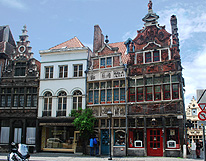 The
square is surrounded by beautiful buildings from different periods,
many from the Renaissance. The step gabled building on the eastern side
with the round tower is the Tanner’s Guild House (Gildenhaus van
de Huievetters), dating from the 15th Century with the guild’s
symbol the mermaid on the weathervane. The Toreken Tower was used by
the Cloth Guild to shame its members, hanging any bolt of cloth which
didn’t pass standards from a ring on the outside for all to view.
The actual headquarters of the guild was the Cloth Measurer’s House
(Lakenmetershuis) dating from 1770 on the north side of the square.
The
square is surrounded by beautiful buildings from different periods,
many from the Renaissance. The step gabled building on the eastern side
with the round tower is the Tanner’s Guild House (Gildenhaus van
de Huievetters), dating from the 15th Century with the guild’s
symbol the mermaid on the weathervane. The Toreken Tower was used by
the Cloth Guild to shame its members, hanging any bolt of cloth which
didn’t pass standards from a ring on the outside for all to view.
The actual headquarters of the guild was the Cloth Measurer’s House
(Lakenmetershuis) dating from 1770 on the north side of the square.
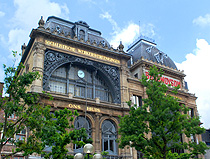 Even
without a prompt you can identify some of the guilds by the relief
sculpting on the fronts depicting the icons of their particular
trade. The most
notable building on the square is the Art Nouveau “Our House” (Ons
Huis) from 1902, which as the sign proclaims was the headquarters of
the Ghent Socialist Worker’s Party which has etched on the side
in Dutch, Karl Marx’ call for the workers of the world to unite.
Marx first published his manifesto in Brussels and his dream of socialism
started in the towns of Belgium, though socialists no longer occupy the
building.
Even
without a prompt you can identify some of the guilds by the relief
sculpting on the fronts depicting the icons of their particular
trade. The most
notable building on the square is the Art Nouveau “Our House” (Ons
Huis) from 1902, which as the sign proclaims was the headquarters of
the Ghent Socialist Worker’s Party which has etched on the side
in Dutch, Karl Marx’ call for the workers of the world to unite.
Marx first published his manifesto in Brussels and his dream of socialism
started in the towns of Belgium, though socialists no longer occupy the
building.
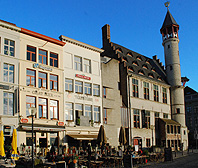 The
Friday Market Square is lined with several restaurants and cafés,
many with outdoor seating for enjoying the day. The Dulle Griet at Number
50 is a haven for beer lovers (see Belgian
Beer Touring).
The bar takes its name from the great red cannon the Dulle Griet (kak
Mad Meg) in the
small square just to the west toward the canal, The cannon served the
Dukes of Flanders in the 1400s until it cracked defending Protestant
Ghent in the revolt in against Catholic Spain (see Count
Egmont & Hoorne
Brussels) in the wars of William of Orange which brought
about the independence of Flanders and the Netherlands. Markets are still
held
on Fridays and
Sundays, with a bird market on Mondays, except for Evil Monday. © Bargain
Travel Europe
The
Friday Market Square is lined with several restaurants and cafés,
many with outdoor seating for enjoying the day. The Dulle Griet at Number
50 is a haven for beer lovers (see Belgian
Beer Touring).
The bar takes its name from the great red cannon the Dulle Griet (kak
Mad Meg) in the
small square just to the west toward the canal, The cannon served the
Dukes of Flanders in the 1400s until it cracked defending Protestant
Ghent in the revolt in against Catholic Spain (see Count
Egmont & Hoorne
Brussels) in the wars of William of Orange which brought
about the independence of Flanders and the Netherlands. Markets are still
held
on Fridays and
Sundays, with a bird market on Mondays, except for Evil Monday. © Bargain
Travel Europe
Find best vacation & hotel deals in Flanders on Trip Advisor
Web
Info
Ghent
Tourism
These articles are copyrighted and the sole property of Bargain Travel Europe and WLPV, LLC. and may not be copied or reprinted without permission.
SEE ALSO:
SUMMER MUSIC FESTIVALS - FLANDERS
HALVE MANN BREWERY TOUR – BRUGES
EUROPE CHRISTMAS MARKETS TOUR BY TRAIN

